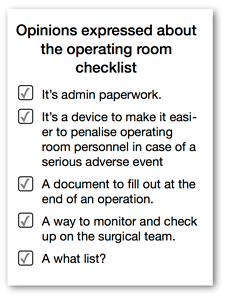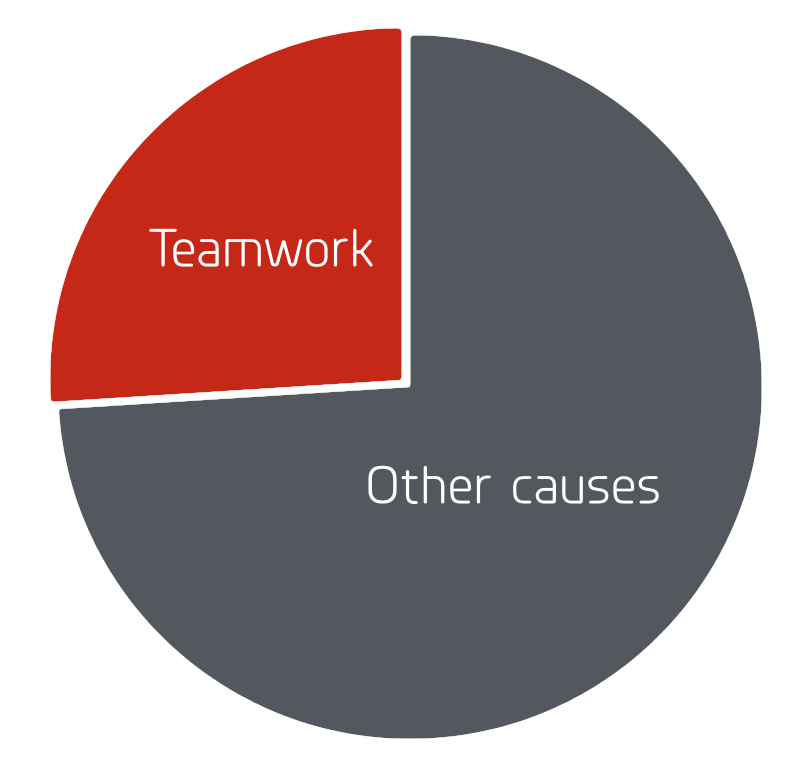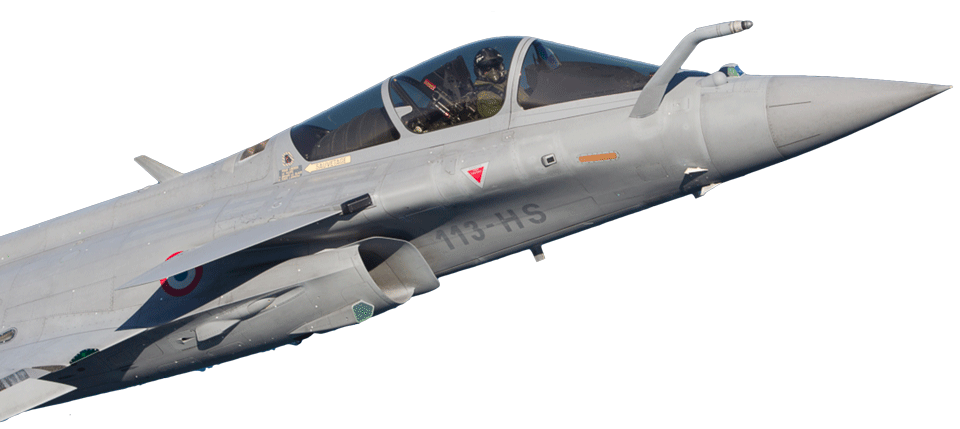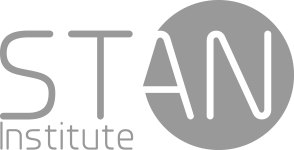Why use a checklist ?
 We make a practice of asking this question every time we work with operating room personnel. The range of responses that we’ve had so far is a perfect illustration of the absence of training, or simply lack of information, about checklist use.
We make a practice of asking this question every time we work with operating room personnel. The range of responses that we’ve had so far is a perfect illustration of the absence of training, or simply lack of information, about checklist use.
Our experience in aviation gives us a totally different outlook on this tool. We wouldn’t contemplate for a moment starting a flight without a checklist, not because it’s compulsory to carry one, but because it’s essential. Checklist use has saved thousands of lives in aviation.
It’s both a line of defence against errors and an aid to briefing
Checklists are designed for one purpose only – to ensure that all the essential steps of a procedure are dealt with. They don’t question the professionalism of the operators; they complete it by acting as a secondary line of defence. A team can be said to have synergy when the actions of the members are coordinated towards a single shared goal. Going through the checklist is a special time of information-sharing, which gives everybody the opportunity to make a vital contribution. It prompts them to use a protocol to secure communication, and it’s an aid to team briefing. The checklist is much more than a simple formality for administration or statistics.
Crew Ressource Management
Everybody has a contribution to make
 A study by HAS, the French National Health Authority*, has shown that 26% of the causes of serious adverse events are linked to the team factor. Problems of communication between professionals represent, on their own, one third of these dysfunctions.
A study by HAS, the French National Health Authority*, has shown that 26% of the causes of serious adverse events are linked to the team factor. Problems of communication between professionals represent, on their own, one third of these dysfunctions.
CRM training courses – Crew Resource Management – are a new learning experience. These courses are inspired by those that aviation crews have been taking for more than 30 years.
The first modules of the Crew Resource Management course include:
- Managing failure to comply (breach, deviation) both as errors and as violations
- A description and the various versions of Reason’s model of human error
- A presentation of the concept of situational awareness (Endsley) and its applications to working in a team.
Medical Team Training
A new dimension in the reinforcement
of individual and collective skills
 In traditional training courses, the participants are seldom put under direct, objective observation of their behaviour and professional practices. However this is a necessary step if they are to develop their own strategies to optimise their skills, in keeping with their own individual and team characteristics. Non-technical skills include decision-making, Situational Awareness, cooperation and leadership.
In traditional training courses, the participants are seldom put under direct, objective observation of their behaviour and professional practices. However this is a necessary step if they are to develop their own strategies to optimise their skills, in keeping with their own individual and team characteristics. Non-technical skills include decision-making, Situational Awareness, cooperation and leadership.
The education team at STAN Institute has adapted the MOST programmes from the air force to the specific requirements of the medical world. The sessions of MTT or Medical Team Training that they’ve created lead healthcare teams to analyse their own actions for “fitness for purpose”, and to work as a team to identify avenues for improvement. Surgical teams are filmed in the OR during real or simulated operations. They then analyse video extracts as a group, so as to determine as a team how best to optimise their individual and collective skills.

Training Timetable
Timetable of the day
- 08H30 – The checklist in the operating room or in the service
- Why a checklist in the operating room or in the service?
- What is a checklist?
- How do you use a checklist?
- Extent of effectiveness
- Design your checklist
- Practical case studies
- 11H30 – Briefing and debriefing
- Why a briefing? Why a debrief?
- What is a briefing? And a debrief?
- How to optimise communications.
- Case studies
- 12H30 – Lunch break
- 13H30 – Team Resource Management
- Error and violation
- Defining our terms
- Managing deviations to eliminate them
- Destigmatizing error
- Reason’s model
- Presenting the model
- Using the model
- Situational Awareness
- 15H30 – Using video in the operating room or in the service
- Installing cameras in the OR or in the service
- 16H00 – Medical procedure *
- 18H30 – Medical Team Training
- 20H45 – Conclusion
- Essential points to take away
* This part of the programme will be adapted to the requirements of the medical procedure
Publications
Trauma team discord and the role of briefing. Steinemann S1, Bhatt A, Suares G, Wei A, Ho N, Kurosawa G, Lim E, Berg B. Steinemann S, et al. J Trauma Acute Care Surg. 2016.
Simulation Improves Nontechnical Skills Performance of Residents During the Perioperative and Intraoperative Phases of Surgery. Nguyen N1, Elliott JO2, Watson WD1, Dominguez E3. J Surg Educ. 2015 Sep-Oct;72(5):957-63. doi: 10.1016/j.jsurg.2015.03.005. Epub 2015 Apr 21.
Coaching Non-technical Skills Improves Surgical Residents’ Performance in a Simulated Operating Room. Yule S1, Parker SH2, Wilkinson J3, McKinley A4, MacDonald J4, Neill A5, McAdam T6. J Surg Educ. 2015 Nov-Dec;72(6):1124-30. doi: 10.1016/j.jsurg.2015.06.012.

